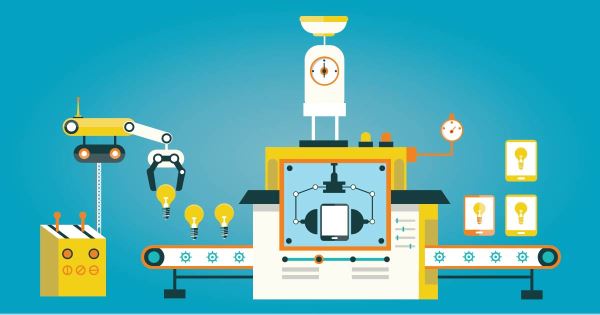Smart factories with efficient and fully connected supply chains are critical to manufacturing innovation.
Industry 4.0 – the fourth industrial revolution – has opened new market possibilities and enabled manufacturers to be more responsive to customer driven trends.
Manufacturing is undergoing a digital transformation.
Significant advances in technology, including big data and analytics, the Internet of Things (IoT), robotics and additive manufacturing, are changing manufacturing operations globally.
“It’s all about collecting and analyzing data to improve efficiency,” says Chris Probst, Omron’s Automation Technology Product Manager.
“The amount of data doesn’t matter – it’s what you do with the data that counts,” he says.
This was one of the key messages from Omron’s Food & Packaging Seminar “Smart Factory Solutions with IoT Technology” held in Sydney, Melbourne and Brisbane this week.
At the seminars Omron, a global leader in automation, unveiled its latest smart factory solutions encompassing Internet of Things (IoT) technology.
This included the latest applications in robotics, machine vision, safety, big data, traceability, PackML and IO link.
Improving profitability
Omron’s team of experts showed how the new technologies can increase productivity and improve profitability in the Food & Packaging sectors.
Mr Probst said many Australian companies are now talking about the Internet of Things (IoT) technical revolution, but not many are prepared for it.
“Companies that embrace new technologies will be better positioned to adapt to changing marketing conditions and customer needs,” Mr Probst said.
They can also boost productivity by up to 30 percent.
“This is the next generation of manufacturing where people and machines work together,” said Mr Probst.
Mr Probst has no doubt collecting data – and using it to measure performance – holds the key to the future for Australian manufacturers.
Hal Varian, professor of information sciences, business, and economics at the University of California at Berkeley and Google’s Chief Economist agrees.
Hugely important skill
“The ability to take data – to be able to understand it, to process it, to extract value from it, to visualise it, to communicate it – that’s going to be a hugely important skill in the next decade,” he says.
Mr Wei-Jian Ong, product manager for Omron’s Sysmac controllers based in Singapore, said data collection and analysis can help manufacturers streamline their operations.
“The collection of data is now vital for industry,” Mr Ong told guests at the Sydney seminar.
“The Internet of Things (IoT) is basically a network of devices with network connectivity for the collection and exchange of data.
“With IoT you can Monitor, Analyse and Act – you can coordinate and monitor your production line. All machines work together to perform at optimum level.
An estimated 13.5 billion devices will be connected by 2020 worldwide.
Common approach for automated machines
Programs such as PackML, or Packaging Machine Language, are now being widely adopted by industry globally, Mr Ong said.
PackML is a universal programming standard defined by the Organization for Machine Automation and Control (OMAC) and by the International Society of Automation's Technical Report 88 which defines a common approach, or machine language, for automated machines.
The primary goals are to encourage a common “look and feel” across a plant floor and to enable and encourage industry innovation.
Omron PLCs can work seamlessly with databases such as SQL, which is the standard language allowing manufacturers to communicate with a database. The SQL database can collect huge amounts of data (Big Data), that can be used to measure the performance of each machine and increase yield.
With Omron’s NJ SQL version controllers you can send the OEE (Overall Equipment Efficiency) data from machine to database and then use that data with MES and ERP systems.
Fully integrated robotic automation solution
“Smart factories need to be more efficient and fully connected to their supply chains,” says Mr Probst.
“Omron offers the industry’s first complete and fully integrated robotic automation solution.
“All of the components are designed to work together.
“Our solutions are developed with Omron’s unified concept – to develop connected, smart, collaborative factories.”
And this is how the concept helps to boost productivity:
- The Connected Factory – seamlessly integrating machine automation and corporate IT to generate, collect and exchange relevant data
- The Smart Factory – intelligent data analysis and evaluation to predict maintenance issues and implement improvements to reduce resources, energy and waste
- The Collaborative Factory – enhancing the interaction between humans and machines.
Omron’s automation solution oversees the entire packaging line, with horizontal and vertical integration, ensuring line coordination and monitoring.
To improve efficiency and improve productivity more factories now turning to robotics – using fixed (Articulated, SCARA and Parallel robots) and mobile robots (AIVs – Autonomous Intelligent Vehicles).
Avoiding obstacles
Omron AIV mobile robots use laser scanners and other advanced technologies that allow them to determine their own path, avoid obstacles and be re-tasked quickly.
They are now being used in a wide variety of applications across warehouses, distribution centres, manufacturing, automotive, food & beverage, hospitality, logistics, health & medical and other challenging environments.
“AIVs not only save on labour costs, they can increase operational efficiency,” says Mr Probst.
“Mobile robots are easy to deploy, with no facility modifications required.
“They work safely around people and can operate 24/7.”
Cost savings
Mr Probst said Smart Factories were also helping to significantly improve workplace safety.
And with improved safety employers can minimise worker injuries, machinery downtime and loss of production.
They can also save on worker’s compensation payouts, compliance fines, court costs and legal and insurance fees.
“The Smart Factory of the future will improve workplace safety, improve yield and traceability, drive down production costs and eliminate errors, says Mr Probst.
“This will enable a ‘flexible’ manufacturing revolution.”


